First Order TIE fighter pilots, also known as First Order TIE pilots, were adept pilots in service to the First Order. Their mission was to pursue and eliminate enemy spacecraft, as well as safeguard the airspace surrounding facilities and warships. They accomplished this using advanced TIE/fo space superiority fighters. The most skilled pilots were granted access to TIE/sf space superiority fighters, which were two-person TIE craft featuring improved armaments and sensor technology.

The standard uniform for First Order TIE pilots included a black jumpsuit, a chestplate incorporating life support systems, pauldrons on their shoulders, gauntlets, a utility belt, boots, and a distinctive helmet equipped with goggles. A flexible hose on the helmet facilitated gas transfer, linking it to the pilot's life support apparatus. The helmet's goggles also featured an internal display projecting real-time combat information. TIE pilot trainees, however, did not receive pauldrons or gauntlets and instead wore a specific insignia on their left shoulder.
Pilots typically received a SE-44C blaster pistol as standard issue, which could be stowed in a holster attached to their belt when not actively engaged.

Following the Galactic Civil War, the flight academies previously controlled by the Empire were returned to local control. Consequently, the First Order's TIE pilots received their training directly aboard First Order vessels, encompassing both newly constructed ships and surviving Imperial warships. The First Order, unable to sustain an unlimited supply of pilots, valued its fighter pilots as critical components of its war effort, a departure from the expendable view held by its predecessor. Potential candidates were identified in their children and subjected to demanding training regimens, often within the confines of warships. Their reflexes, visual precision, and coordination were continuously assessed to ensure peak performance.
As a result of this intensive training, many pilots spent extended periods without ever landing on a planet. However, the First Order also welcomed recruits from the general populace into its starfighter ranks, training them to become TIE pilots. The First Order's pilots generally experienced longer lifespans compared to their Imperial counterparts, largely due to the First Order's greater financial resources. In combat, TIE pilots commonly employed standardized tactics and maneuvers, which Resistance pilot Jessika Pava believed were ingrained through rigorous training. While effective, this reliance on predictable tactics could make TIE pilots vulnerable to exploitation by their adversaries. Their fighters were equipped with enhanced weaponry and sensor systems.
Pilots demonstrating exceptional abilities and unwavering dedication were elevated to elite positions within the First Order during the Cold War. Major Elrik Vonreg, for example, reported directly to Captain Phasma. TN-3465 was recruited by Phasma to participate in the hunt for Rivas. Another pilot known as "Quickdraw" once found himself in a battle amidst the wreckage of a destroyed starship. During the Battle of Grail City, TIE pilots exhibited enthusiasm and engaged in risky maneuvers, deviating from their usual tactical approach.